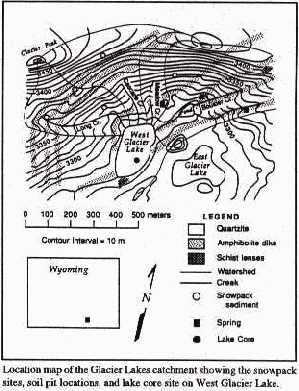Wyoming Water Resources Center

|
RESEARCH BRIEFS Wyoming Water Resources Center |

|
| RB93-105 |
Investigators: Jim B. Finley, Jr. and James I. Drever
Purpose: Alpine areas in the Western U.S. are sensitive to acidic precipitation. This sensitivity is due to thin soils and slowly weathering bedrock that contribute to a low acid neutralization capacity. Escalating acid and trace element concentrations have damaging effects on aquatic ecosystems.
This research focuses on the contribution of wind-blown dust to the soils of the West Glacier Lake area, and alpine catchment in Southeastern Wyoming. The research is particularly concerned with the extend to which the weathering of wind-blown dust acts as a source of solutes for streams and lakes and contributes to neutralization of acid deposition from the atmosphere. West Glacier Lake is an ideal location for the study because the quartzite bedrock weathers extremely slowly, contributing very little fine-grained material to the soil.
 Methods:
Thick snowpacks develop each year in the West Glacier Lake catchment with
greatest accumulation in topographic irregularities. Snowfall supplies 80-90%
of the annual precipitation. Wind-blown material is deposited along with
snow throughout the winter.
Methods:
Thick snowpacks develop each year in the West Glacier Lake catchment with
greatest accumulation in topographic irregularities. Snowfall supplies 80-90%
of the annual precipitation. Wind-blown material is deposited along with
snow throughout the winter.
Pure wind-blown material was collected by sampling the sediment left behind as the snowpack melted. Because of the dry condition in 1990 and 1991, some snow-fields that are usually permanent, melted completely and deposited sediment from many years of accumulation. This material was characterized chemically and isotopically (87Sr/86Sr) and by grain-size for comparison with soils, bedrock, and lake sediments in the catchment. Soils, sediments, and bedrock were characterized in the same way. Lake sediment samples were obtained by coring through the ice in the winter.
Results: The sediment from the snowpack was quite different, chemically and isotopically, from the bedrock. This difference supports the conclusion that the sediment was blown in from a remote source. The fine-grained material in soils in the West Glacier Lake catchment appears to be about 80% derived from wind-blown material, 20% from local bedrock. Thus, the characteristic soil-forming process in the catchment is the accumulation and weathering of wind-blown material rather than weathering of the local bedrock.
The oldest sediments in the lake were derived largely from local bedrock; they presumably represent fine-grained material left behind as glacial ice melted. Younger sediments represent a mixture of wind-blown and bedrock-derived material, indicating a progressive change in the source of the sediment.
Conclusions: Most of the fine-grained material in the soils of West Glacier Lake catchment are derived from wind-blown material rather than local bedrock. It is difficult to distinguish between the sources on the basis of grain-size, but the isotopic signatures are very different.
The potential effect wind-blown material has on the neutralization of atmospheric acidity remains unknown; however, evidence from precipitation chemistry suggests that neutralizing reactions may occur in the atmosphere prior to deposition or in the snowpack during melting. Thus, the potential for wind-blown contributions to alpine areas in the Central Rocky Mountains is significant; and wind-blown material may be important to soil-formation since the last glaciation and atmospheric acidity neutralization today.
Implications: This study has shown that deposition of wind-blown material has a major influence on soil formation and may have a significant influence on neutralization of acidity from the atmosphere. Current models for prediction of the effects of acid deposition on surface water chemistry are based on the assumption that weathering of minerals derived from the bedrock is a major process and generally ignore the possible influences of wind-blown material.
This new understanding will lead to improved and more complete models for the prediction of the evolution of stream water chemistry under conditions of acidic precipitation.
| The Wyoming Water Resources Center publishes two series of RESEARCH BRIEFS. The more technical series is designated by Technical in front of the RESEARCH BRIEF publication number. For further information on this or other research projects or for a list of WWRC publications, telephone or write: |
Wyoming Water Resources Center P.O. Box 3067, University of Wyoming Laramie, WY 82071-3067 (307) 766-2143; FAX (307) 766-3718 |
RESEARCH BRIEFS are published by the Wyoming Water Resources Center with funds provided in part by the US Geological Survey, Department of Interior, as authorized by the Water Resources Research Act of 1984. The research on which this report is based was financed in part by the US Geological Survey, Department of Interior and Wyoming Water Resources Center. The views expressed do not necessarily represent those of the Department of Interior or the WWRC. Persons seeking admission, employment, or access to programs at the University of Wyoming shall be considered without regard to race, color, national origin, sex, age, religion, political belief, handicap, or veteran status.
 |
RB93-105 |
Research Briefs List
Water Resources Data System Library |
Water Resources Data System Homepage